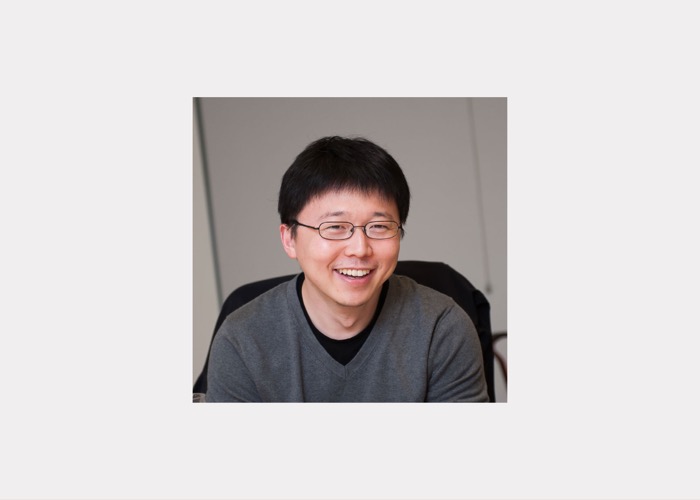
Sydney Brenner famously noted that progress in genetics “depends on the interplay between new techniques, new discoveries, and new ideas, probably in that order of decreasing importance.” In the 40 years since those words were recorded, new techniques have propelled the field of molecular biology to heights barely imagined at its inception.
This year’s recipient of GSA’s Edward Novitski Prize, Feng Zhang of the McGovern Institute for Brain Research and the Broad Institute, proves that Brenner’s adage requires an addendum: in many cases, the process of developing new techniques draws on new ideas and new discoveries. Zhang’s ideas and discoveries paved the way for two revolutionary techniques that have become indispensable to molecular biologists: optogenetics and CRISPR.
“He revealed his brilliance from the very beginning,” says Karl Deisseroth of Stanford University, who was Zhang’s graduate advisor. “The technology we developed in my lab, called optogenetics, requires the convergence of several different streams of technology innovation, and Feng was really central to all of those streams.”
Optogenetics uses light-activated ion channels, called opsins, to create an electrical signal. By engineering brain cells to produce opsins, researchers can then activate just those cells by exposing them to light. The first successful demonstration of optogenetics used a protein from algae called channelrhodopsin, which responds to blue light and activates neurons by moving sodium ions into the cell.
Zhang’s key contributions helped make the technology broadly useful for a variety of experimental uses. First, he discovered new opsins, including the first red light-activated channelrhodopsin, and halorhodopsin, an opsin that transports chloride ions rather than sodium ions. Halorhodopsin enables selective silencing of neuron activity, adding incredible versatility to the optogenetics system. He also developed a viral delivery system that enabled cell-type specific targeting of opsins.
“You can make all the opsins you want, but if you can’t target them in a versatile and generalizable way to specific kinds of cells, you actually haven’t really done much,” Deisseroth says. “That was extremely difficult, and it wasn’t clear how to do that in a generalizable way at the time. Feng developed a very elegant viral targeting strategy.”
The Edward Novitski Prize recognizes an extraordinary level of creativity and intellectual ingenuity in the solution of significant problems in genetics research. Zhang’s contributions to optogenetics demonstrate plenty of intellectual ingenuity, and then he moved on to an equally impressive tool: CRISPR.
“I got interested in genome editing because of wanting to solve this problem for optogenetics,” Zhang recalls. He began by trying to customize zinc finger nucleases to enable cell-type specific expression of different opsins, but designing a different zinc finger for each target gene was laborious. Next, he worked with TALE nucleases, which were easier than zinc fingers but still time consuming. “Nevertheless, I was excited about this gradually making the system easier and easier to use,” he says. “Then, as I was working on TALEs and teaching my students to use it for their projects, I went to a talk, and I learned about CRISPR systems.”
CRISPR is an adaptive bacterial immune system that allows the cell to recognize and attack viral nucleic acids. Zhang realized that CRISPR nucleases could be the answer to the problem he’d been working on, and he set about developing them for use in mammalian cells.
“This ability to redirect where to target in the DNA without having to change the protein is very powerful,” he says. Zhang refocused his efforts from TALEs to CRISPR, specifically, the Cas9-containing systems. He engineered Cas9 to function in human cells, a watershed moment for genome editing technology.
To expand the utility of CRISPR, just as he’d plumbed nature’s rich toolbox for new types of opsins, he went looking for other CRISPR enzymes in various bacterial species. “Nature is very amazing — it evolved everything that is on this planet,” he says. Using this approach, he discovered that Staphylococcus aureus made a smaller Cas9, which is more amenable to viral delivery, a key aspect of in vivo genome editing.
Over the next two years, he published 22 papers reporting major advances in CRISPR/Cas9 editing. He showed how to dramatically reduce off-target cutting by Cas9 and developed a method of whole-genome loss-of-function CRISPR screening, a powerful tool for gene identification that “will have enormous ramifications in biomedical research,” writes Bert Vogelstein, Director of the Ludwig Center for Cancer Genetics & Therapeutics at Johns Hopkins and one of the scientists who nominated Zhang for the award.
“Dr. Zhang has done, and continues to do, fantastic work,” Vogelstein says. “Through his sharing ideas and materials with the research community, he has enabled numerous laboratories to make major scientific advances.”
More recently, Zhang has discovered new CRISPR enzymes that behave differently than Cas9, including Cas13, which targets RNA. Using Cas13, Zhang helped develop a nucleic acid test called SHERLOCK (“specific high sensitivity reporter unlocking”), which was used to create rapid point-of-care SARS-CoV-2 tests.
As a mentor, Zhang emphasizes collaboration to advance science by combining different people’s expertise. “It also makes doing research more fun,” he says. “You make many more friends from around the world. That is one of the most valuable things that I get from working on these problems.”
He encourages students to be curious about everything and find something that excites them. “That’s the best way for people to be creative and really exceed even their own imagination,” he says. “Once a student finds that passion, then as a mentor my job is to support them with everything I can and help them develop their idea, both scientifically and also teaching them how to engage in meaningful and rewarding collaborations with other people.”
Zhang’s work has previously been recognized with the Alan T. Waterman Award from the National Science Foundation (2014), the Canada Gairdner International Award (2016), the Tang Prize (2016), the Albany Medical Center Prize (2017), the Lemelson-MIT Prize (2017), and the Richard Lounsbery Award from the National Academy of Sciences (2021), among others.
“He’s an incredibly humble guy,” Deisseroth says. “One of the nicest guys you’d ever meet, and a great collaborator.”
Watch Feng Zhang’s GSA Award Seminar: “RNA-Guided DNA Insertion with CRISPR-Associated Transposases”
The Edward Novitski Prize recognizes an extraordinary level of creativity and intellectual ingenuity in the solution of significant problems in genetics research. The prize honors scientific achievement that stands out from other innovative work, that is deeply impressive to creative masters in the field, and that solves a difficult problem in genetics. It also recognizes the beautiful and intellectually ingenious experimental design and execution involved in genetics scientific discovery.































